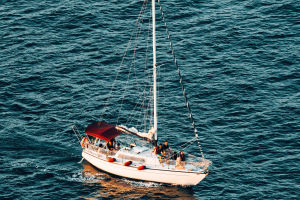The ocean’s color has intrigued and fascinated people for centuries. You may have noticed that the water in some parts of the world looks deep blue, while in other places, it’s more of a greenish hue.
But why does this happen? Is it simply a matter of perception, or is there something scientific going on? This article unravels the mystery behind these changes in color and gives you a glimpse into the factors that affect the appearance of our seas.
The Science Behind the Color of Water
At first glance, it may seem like water should be transparent, and it is—at least in small quantities. However, when you look at large bodies of water, especially the ocean, you begin to notice that they take on colors like blue, green, or even brown in some instances. This happens because of the way light interacts with water molecules and the things suspended in the water.
When sunlight hits the surface of the water, it contains all the colors of the spectrum: red, orange, yellow, green, blue, indigo, and violet. Water absorbs colors in the red part of the light spectrum more than those in the blue. As a result, the light that is reflected back from the ocean is primarily blue, which is why clear ocean waters often appear blue.
Why Green Water?
If blue is the default color for water, what causes it to turn green in some areas? The green color in the water is often due to the presence of algae, phytoplankton, and other microorganisms. These tiny organisms contain chlorophyll, the green pigment responsible for photosynthesis. The more algae or phytoplankton present, the greener the water will appear.
For instance, coastal waters, where nutrients from rivers or coastal runoffs mix with the ocean, are often rich in these microorganisms. This is why you’re more likely to see green water near shorelines or in areas where nutrient levels are higher, such as the mouths of large rivers. The presence of chlorophyll absorbs the red and blue light, leaving more green light to reflect back.
Turbulence and Sediment
Another factor that influences the color of water is turbulence. In shallow areas or places where strong currents stir up the seabed, the water can take on a brownish or muddy appearance. This happens because sediment, such as sand, silt, and organic materials, becomes suspended in the water, scattering the light and altering its color.
Interestingly, some lakes and rivers can take on a similar greenish or even milky appearance because of the presence of minerals or fine sediments, especially in areas where glacial runoff occurs. These particles act in the same way, altering the reflection and refraction of light to produce various shades of green, brown, or even turquoise.
Depth and Location
The depth of the water plays a significant role as well. Deep ocean water absorbs more light, reflecting a darker blue color. Conversely, shallow water, especially over sandy bottoms, reflects more light, which can give it a lighter blue or turquoise hue. Tropical destinations, like the Caribbean or the Maldives, are known for their crystal-clear, turquoise waters thanks to the shallow, white sandy bottoms and minimal algae.
Different latitudes and environmental conditions also come into play. For example, polar regions tend to have greener water because the colder temperatures favor the growth of phytoplankton, while tropical regions, with their warm, nutrient-poor waters, often appear more blue.
A Spectacle of Nature
The varied colors of seawater are more than just a beautiful sight; they are a reflection of the complex interactions between light, water, and the environment. Whether you're marveling at the deep blue waters of a tropical paradise or gazing at the green-hued coastal areas rich in marine life, understanding what causes these changes in color adds an extra layer of appreciation.
It’s not just about aesthetics, either—these colors tell a story about the health and composition of the ocean. Algal blooms, for instance, might give off a beautiful green hue, but they can also signal ecological shifts or even potential issues in the marine ecosystem.
The next time you visit the ocean, take a moment to observe the water’s color and think about the fascinating science that’s unfolding before your eyes.
Lykkers, remember, the world’s waters have many stories to tell, and they’re waiting for you to discover them. Dive in and explore the vibrant hues of our oceans. You might just learn something new along the way!


